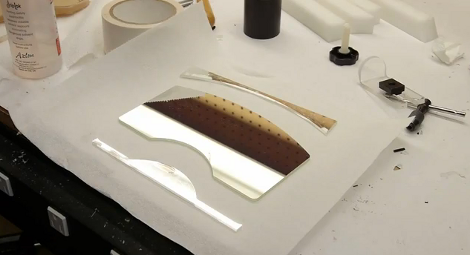
[Ben Krasnow] is working on a project that uses an extremely expensive specialty mirror. He needed to cut curves into it, taking care not to chip or shatter the material. He’s found a reliable way of doing this with a CNC mill and is sharing his methods.
The material he’s working with is a cold mirror; it reflects visible light while allowing infrared light to pass through. He had to custom order it, breakage is not acceptable. [Ben] explains that the biggest risk when milling glass is the clamping method used. He built his own jig and uses shims, rather than clamps, to secure the material along the X and Y axes. It is held down on the Z axis using a bar of acrylic spanning from one side to the other with rubber feet on the bottom.
A diamond burr cutter does the work, spinning at 3000 RPM. [Ben] recommends moving the head at the slowest rate possible in order to give the cutter time to do its work. And of course the material needs to be kept cool by pumping cutting fluid across it. As he shows in the video after the break, what you get is a piece of glass that comes out with clean and smooth edges.
In case we’ve sparked your curiosity, this mirror will be used during an MRI scan. The patient looks at a monitor reflected in the mirror at a 45 degree angle. At the same time, an infrared camera records the patient from the other side of the mirror to monitor where they are looking.
[youtube=http://www.youtube.com/watch?v=HyI111Tn0Cs&w=470]















HAD is uber cool today… What happened?
While HAD has been creating original content to post, traditionally HAD posts only what it ran across on the web. Obviously HAD, and HAD readers depends on others posting their interesting projects to the web. Must be a big crap shoot, but it would be interesting to learn how the HAD staff goes about finding content.
Amazing!
What is this, Ben’s 3-4th Hack-A-Day entry? :D
Keep up the good work!
Amazing work, but if I had paid a lot of money for a mirror, I would invest a few hundred bucks more to have it cut by professionals :)
I think he might qualify as a professional. They propably asked him to develop this filter for an MRI study
Our company has custom mirrors cut, often costing upwards of $5,000. We use a waterjet…
Wow, sounds like they’re doing fMRI in the context of some behavioral task while they do eye-tracking. Very cool
If you paid that much for a mirror with a sensitive coating, I certainly would *not* be running cutting fluid across it unless I’m absolutely sure it’s clean and free of foreign debris.
Semi colon!
This is one of the best hacks I’ve seen on Hack A Day for a while. Ben Krasnow, thank you for sharing this awesome work. I have a couple projects that can use specially-shaped mirrors, and this will come in very handy.
wow!
A waterjet is also suitable to cut glass. You would want to start outside unless you had a method of turning on the abrasive first and then the water – to minimize the chances of cracking. This method, combined with lowering the pressure will generally allow you to pierce glass without it breaking. But overall, just cut from the edge – quite a bit faster than the CNC machine as well as the waterjet tends to smooth the edges a bit.
I in the past successfully hand-drilled a hole in glass with a diamond (chinese-)dremel bit, while cooling it by submerging it in a shallow pool of water (as a bonus that also keeps the glassdust away), but you must indeed go relatively slow.
I was pleasantly surprised it went so well.
If you use a regular glass drill you need a good surface to put the glass on and need to be careful with the pressure, and a diamond bit is more sanding the stuff away as it were so in a sense that’s an advantage I think.
Often, when working with coated optics, the part being cut is sandwiched between two similar pieces of uncoated glass (usually cheap float glass) with “blocking wax” for protection. Bound diamond abrasives work well (think grinding rahter than milling). Waterjet may work – it is often used for uncoated optics… but the relatively thick coating stack required to make a long-wave pass may not hold up. Once a coating starts delaminating, it’s a short trip to catastrophic failure.
Nice Work… couldn’t you just use a vacuum table? What qualifies as as suitable coolant for first reflection mirrors?
@whatnot, is cavitation a problem with fully submerged cutting heads? Very intersting hack.
I think he’s brave to use a clamp of any kind for work-holding glass. There are alternatives such as mitee-grip sheet. It’s a precision-flat wax impregnated sheet that you use to stick a workpiece to a machine-table, or more likely to a thick metal sub-plate that will in turn be clamped to the table. The adhesion can be turned on and off by warming the setup enough to melt the wax.
There are also various adhesive/solvent methods to stick and then release a fragile workpiece instead of using clamps.